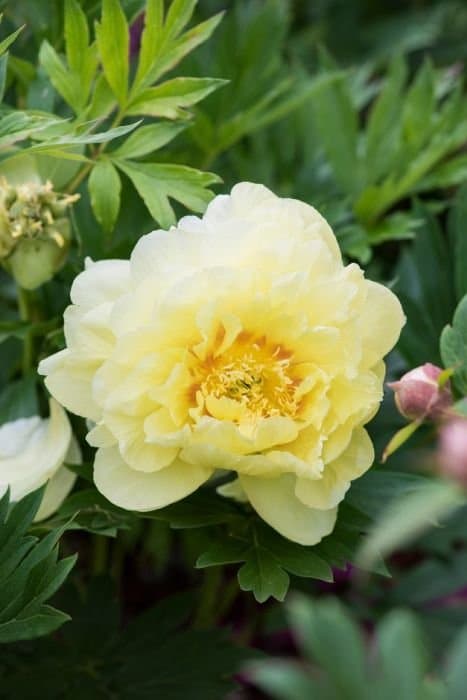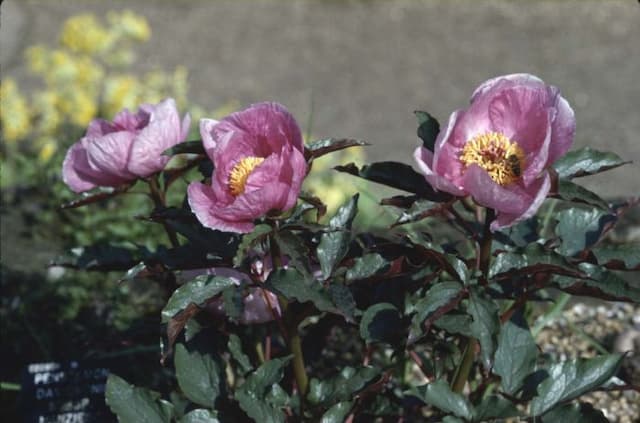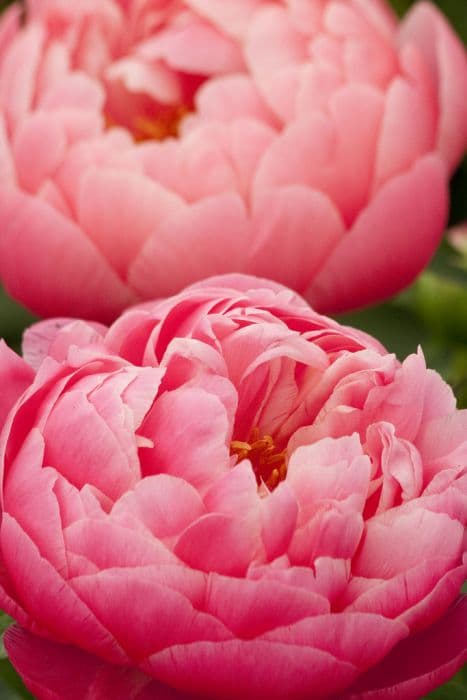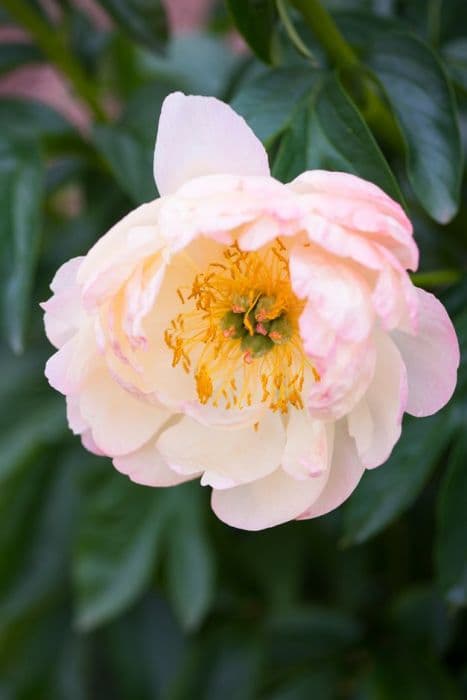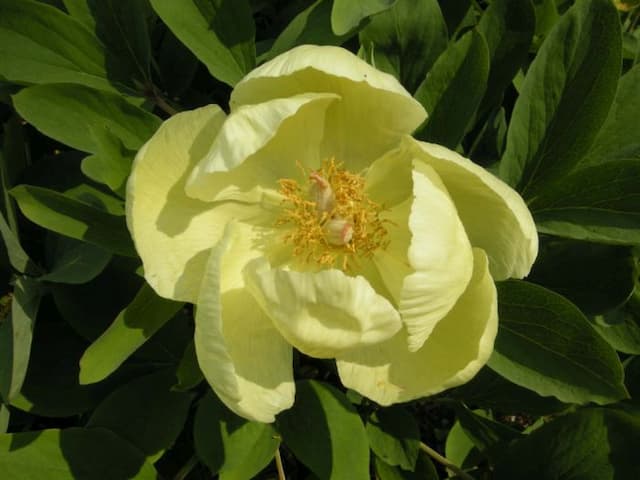Peony Paeonia 'My Love'
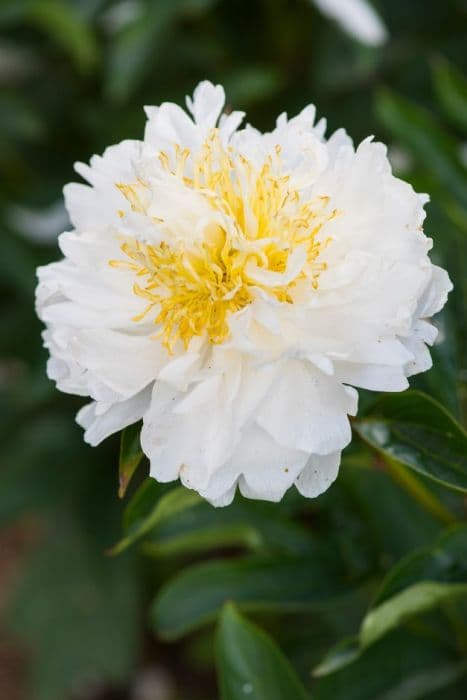
ABOUT
Paeonia 'My Love' is an eye-catching perennial commonly known as a peony. This stunning plant is admired for its beautiful blooms, which can vary in color. The flowers of 'My Love' showcase an exquisite palette, often featuring creamy white petals that may have blushes of pink, giving them a romantic and soft appearance. The petals are usually arranged in a dense, round shape, which is characteristic of many double-flowered peonies, creating a lush, full look that adds a touch of elegance to any garden setting. The foliage of 'My Love' peony consists of deep green leaves that provide a rich contrast to the delicate tones of its blossoms. These leaves are broadly divided and have a glossy surface that catches the light, adding to the plant's overall visual impact. The peony's robust stems rise from the ground and branch out, providing sturdy support for the heavy flowers, which are cherished for their size and form. Each bloom emits a lovely fragrance that is lightly sweet and often described as classic to peonies, making 'My Love' a favored choice for gardens where scent is an important element. As a perennial, the 'My Love' peony grows back each year, bringing its timeless beauty to the landscape and enchanting gardeners and passersby alike. It is important to note that peonies, including 'My Love,' typically bloom during the spring and early summer, providing a show of color when many other plants are just beginning to wake up from their winter rest. The blooms can serve as a focal point in floral arrangements and are a popular choice for special occasions such as weddings.
About this plant
 Names
NamesFamily
Paeoniaceae
Synonyms
Peony, Paeony
Common names
Paeonia 'My Love'
 Toxicity
ToxicityTo humans
The peony, specifically Paeonia 'My Love', is generally not highly toxic to humans. While eating large quantities might cause stomach upset, peonies are not considered dangerously poisonous for people. If ingested, symptoms could include nausea, diarrhea, or vomiting. It is always wise to avoid eating ornamental plants because of potential individual sensitivities or allergic reactions.
To pets
For pets, peonies can be considered mildly toxic. If ingested, pets might experience symptoms such as vomiting, diarrhea, or drooling. In severe cases or when large amounts are consumed, it may lead to lethargy or coordination problems. It's important to keep peonies out of reach of pets to prevent these possible toxic effects.
 Characteristics
CharacteristicsLife cycle
Perennials
Foliage type
Deciduous
Color of leaves
Green
Flower color
White
Height
2-3 feet (0.6-0.9 meters)
Spread
2-3 feet (0.6-0.9 meters)
Plant type
Herbaceous
Hardiness zones
3-8
Native area
Asia
Benefits
 General Benefits
General Benefits- Ornamental Appeal: Paeonia 'My Love', commonly known as peony 'My Love', has large, attractive blooms that enhance the aesthetic appeal of gardens and landscapes.
- Variety of Colors: The peony 'My Love' offers a spectrum of colors through its blossoms, which can include white, pink, and red, adding a striking visual element to the environment.
- Fragrance: These flowers are known for their delightful fragrance, which can create a pleasant atmosphere in any space where they are planted.
- Longevity: Peonies can live for a very long time, often outliving the person who planted them, making them a lasting investment for a garden.
- Low Maintenance: Once established, peonies require minimal care, making them a convenient choice for gardeners of all skill levels.
- Cut Flowers: The blossoms of peonies 'My Love' make for beautiful cut flowers that can be used in arrangements and bouquets, extending their beauty indoors.
- Attracts Pollinators: Peonies help support the ecosystem by attracting bees and other pollinators to the garden, aiding in pollination of surrounding plants.
 Medical Properties
Medical PropertiesThis plant is not used for medical purposes.
 Air-purifying Qualities
Air-purifying QualitiesThis plant is not specifically known for air purifying qualities.
 Other Uses
Other Uses- Paeonia 'My Love', commonly known as Peony, can be used in perfumery for its alluring fragrance to create romantic and floral scent profiles.
- Peonies can serve as natural dyes for fabrics, providing a soft pink to light red hue when the petals are processed and used in dye baths.
- The petals of Peony can be crystallized and used as an elegant, edible decoration for cakes and desserts, adding an element of sophistication.
- Peony petals can be added to homemade potpourris, contributing their pleasant scent and decorative appeal to the mixture.
- Used in art, Peony blooms are a popular subject for botanical watercolor artists and photographers seeking to capture their beauty.
- The roots of the Peony plant are sometimes carved into artistic shapes and figures by skilled craftspeople, although this is less common.
- Pressed Peony flowers can be incorporated into bookmarks, greeting cards, or other paper crafts as a decorative feature.
- Peony blossoms can be used to create natural confetti for weddings or festive events, providing a biodegradable alternative to synthetic confetti.
- The large leaves of some Peony varieties can be used as natural wraps for small gifts or in floral arts for creating a unique presentation.
- Peony plants can be interplanted in vegetable gardens to attract beneficial insects that prey on common garden pests, aiding in integrated pest management.
Interesting Facts
 Feng Shui
Feng ShuiThe Peony is widely recognized in Feng Shui as a symbol of wealth, prosperity, and a happy marriage, making it a favorable plant to use in the southwest sector of a garden or home to enhance love and romance.
 Zodiac Sign Compitability
Zodiac Sign CompitabilityThe Peony is not used in astrology practice.
 Plant Symbolism
Plant Symbolism- Prosperity: In many cultures, peonies symbolize wealth and honor, and are often associated with an abundance of luck and good fortune.
- Romance: The 'My Love' variety's name itself suggests a strong romantic connotation, signifying deep love and affection.
- Beauty: Peonies are often viewed as a symbol of beauty in all forms, with their lush, full blooms and vibrant colors.
- Compassion: They can represent a sense of nurturing care and compassion towards others.
- Honor and Nobility: Due to their regal appearance, peonies can symbolize honor and the high esteem of nobility, especially in Eastern cultures.
- Happy Marriage: Because of their romantic connotation, peonies are considered auspicious for a happy and successful marriage.
 Water
WaterPeonies, including the 'My Love' variety, should be watered deeply once a week if there hasn't been substantial rain. They need about 1 inch of water weekly, which translates to approximately 0.623 gallons per square foot of soil. The best method for watering is to use a soaker hose or drip irrigation early in the morning; this allows the leaves to dry off during the day, reducing the risk of fungal diseases. Avoid overhead watering to prevent diseases. It's crucial to maintain consistent moisture, particularly during the growing season, but allow the soil to dry out between waterings to prevent root rot.
 Light
LightPeonies, such as 'My Love,' thrive in full sun conditions. The ideal spot for planting peonies is where they can receive at least six hours of direct sunlight each day. While they can tolerate light shade, they may produce fewer flowers in such conditions, and their stems might not be as strong.
 Temperature
TemperaturePeonies like 'My Love' prefer a temperate climate with their ideal growing temperatures ranging between 65°F and 75°F. They are hardy and can tolerate winter temperatures down to about -20°F, which allows them to go dormant and rest for the next growing season. During the hot summer months, temperatures above 85°F may impact their blooming cycle and overall health.
 Pruning
PruningPeonies like 'My Love' should be pruned to remove dead or faded flower heads after blooming, which encourages healthy growth and improves airflow. In fall, after the first frost, cut back the foliage to the ground to prepare the plant for winter and reduce the risk of disease. Peonies should be pruned at least once annually during these times.
 Cleaning
CleaningAs needed
 Soil
SoilPeonies prefer well-draining soil with a pH of 6.5 to 7.0. A mix containing two parts loam, one part sand, and one part compost or well-rotted manure is ideal for peony 'My Love', ensuring good drainage and fertility.
 Repotting
RepottingPeonies like 'My Love' seldom need repotting as they are long-lived perennials. Once planted, they can thrive in the same location for decades without repotting, provided the soil conditions and location are suitable.
 Humidity & Misting
Humidity & MistingPeonies, including 'My Love', are tolerant of a wide range of humidity levels. They perform best in average garden conditions without the need for additional humidity control.
 Suitable locations
Suitable locationsIndoor
Peonies are not ideal for indoor growth; they require dormancy.
Outdoor
Plant in full sun to part shade, and ensure well-drained soil.
Hardiness zone
3-8 USDA
 Life cycle
Life cycleThe Paeonia 'My Love', commonly known as Peony 'My Love', begins its life as a seed, sown just below the soil surface where it germinates, usually requiring a period of cold dormancy to trigger sprouting. Upon germination, the seedling emerges and develops into a young plant with a small set of true leaves, establishing a root system. As it matures, the peony grows larger, forming a clump of green foliage and a robust root system that includes tuberous roots which store energy for the plant. During spring, it enters a phase of rapid growth, eventually producing buds that bloom into large, often fragrant flowers typically during late spring or early summer. After flowering, seed pods may form if flowers were pollinated, and as the growing season progresses, the foliage gathers energy and nutrients for the next cycle before dying back to ground level in the fall. The plant then enters dormancy over the winter months, with the root system remaining alive underground, ready to restart the cycle again the following spring.
 Propogation
PropogationPropogation time
Early spring
The Paeonia 'My Love', also known as the peony, is typically propagated through root division. This is the most popular method for peonies and is best done in the fall after the plants have gone dormant. To propagate by division, gardeners should dig up the peony clump and gently separate the root mass into sections, making sure that each section has at least three to five eyes, which are the potential growth points for new shoots. The divisions should then be replanted at the same depth they were growing before, usually about an inch and a half (approximately 3.8 centimeters) below the soil surface, and spaced about three feet (about 91 centimeters) apart to provide adequate room for growth. Good drainage and full sun exposure are critical for the healthy development of new peony plants.
